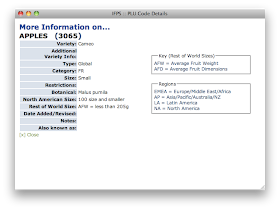I probably should have turned this sticker right-side-up for the photo. Oops :)
When shopping, one quick glance at the sticker tells you whether the produce is organic, conventional, or genetically modified.
Here is the basic information to remember:
- The 4-digit code tells you what the produce is. For example: 3065 is a cameo apple
- Organic produce adds the number 9 to the front of that code. For example: 93065 is an organic cameo apple
- Genetically modified produce adds the number 8 in front of the code. For example: 83065 would be a cameo apple that has been genetically modified.
In the photo above, the label actually shows that the apple is certified organic, Cameo, and that it was grown in the USA. Some stickers will also show what state the produce comes from. But not all stickers have all of that information right on the label. Some only have the code.
So, if you are a data geek like me, know that you can input the 4-digit code in this database, to find out even more information about the apple. You can see below that it tells you the variety, botanical name, size, and growing region. This actually isn't the best example- some entries have more information than others (click on photo to enlarge).
The pluot below has a 9 in front of the 4-digit code, which indicates that it was grown organically. Again- that's a quick and easy way to tell if something is (or is not) organic when you are in the grocery store.
When you input the code in the PMA database, use only the 4-digit code (omit the 9).
Here's another pluot. This one does not have a 9 in front of the 4-digit code, so that means it was grown conventionally. Trust me, you'll get very fast at spotting the 9, and noticing when it is not there. It will become second nature.
Here's another example of when this comes in handy- at the Farmer's Market last week, our favorite organic farmer had some lettuces that he'd brought in from a farm in another state. Those items had labels. They did not begin with a 9. Yet he told us that they were organic. But the label clearly did NOT have a 9, and was only 4-digits. I still bought them, but this tip is good to know if there are certain items, such as the dirty dozen, that you wish to purchase only if they are organic. You cannot always trust the sign in the grocery or what the local produce guy tells you. People make mistakes. If organic is important to you, the 9 on the label is very useful information!
Try this at home if you are curious:) Sometimes I'll buy an item and really like it, but I don't know what variety it is. The database will tell you, and then you know what to look for next time.
The PMA database contains codes for dried fruits, fruits, veggies, herbs and nuts. Pretty cool.
ADDITION: The 9 identifies items that are Certified Organic by the USDA/EU. Some produce may be grown without chemicals or pesticides, but for various reasons may not be certified organic. Ask your local grower for more information about how their produce is grown- they are the best ones to answer your questions. Ask yourself what is most important to you in the foods you consume. It may be that you can find locally grown produce that meets (or nearly meets) your needs even if it is not USDA/EU Certified Organic (which includes a lot more criteria than just grown without chemical pesticides).





No comments:
Post a Comment